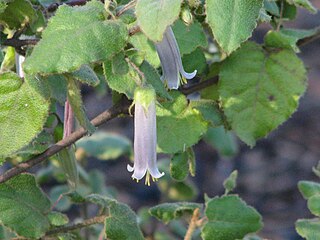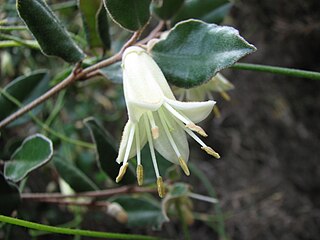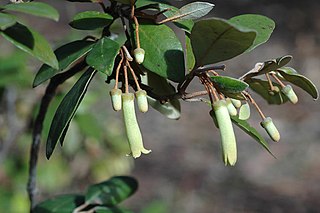
Correa is a genus of eleven species of flowering plants in the family Rutaceae that are endemic to Australia. Plants in the genus Correa are shrubs to small trees with simple leaves arranged in opposite pairs, bisexual flowers with four sepals, four petals usually fused for most of their length and eight stamens.

Correa alba, commonly known as white correa, is a species of shrub that is endemic to south-eastern Australia. It has egg-shaped to more or less circular leaves, erect white flowers arranged singly or in groups on short side branches, and green fruit.

Correa lawrenceana, commonly known as mountain correa, is a species of shrub or small tree of the family Rutaceae and is endemic to Australia. It has elliptical to egg-shaped leaves arranged in opposite pairs and cylindrical, greenish yellow to red flowers usually arranged singly or in groups of up to seven in leaf axils with the stamens protruding beyond the end of the corolla.

Correa calycina, commonly known as the South Australian green correa or Hindmarsh correa, is a species of tall, dense shrub that is endemic to a small area of South Australia. It has papery, oblong leaves and pendulous green flowers arranged singly on the ends of short side branches.

Correa aemula, commonly known as the hairy correa, is a species of shrub that is endemic to south-eastern Australia. It has broadly heart-shaped leaves arranged in opposite pairs, green or greyish green, pendent flowers arranged singly or in pairs and ageing to mauve-purple.

Correa backhouseana is a species of rounded shrub that is endemic to coastal and near-coastal areas of southern Australia. It has elliptical to egg-shaped or round leaves that are densely hairy on the lower surface, and cylindrical to funnel-shaped, cream-coloured to pale green or red and yellow flowers.

Correa decumbens, commonly known as the spreading correa, is a species of prostrate to spreading shrub that is endemic to South Australia. It has narrow oblong to narrow elliptical leaves and narrow cylindrical, pink to red flowers with green lobes.
Correa eburnea, commonly known as the Deep Creek correa, is a species of shrub that is endemic to the Fleurieu Peninsula in South Australia. It has papery, elliptic to egg-shaped leaves, and up to five green, nodding flowers arranged in leaf axils.
Correa glabra var. turnbullii, the narrow-bell correa, is a variety of Correa glabra, a shrub native to Australia. It grows to 1 to 2 metre high and wide, with branchlets sparsely covered with rust-brown hairs. Its leaves are up to 4.5 cm long and 1.2 cm wide and are dark green on the upper surface, while the lower surface is covered with hairs and pale grey. The pendent, tubular flowers are pink or red with green tips, appearing between April and August in their native range.
Correa reflexa var. lobata, commonly known as Powelltown correa is a variety of Correa reflexa endemic to Victoria in Australia. It grows to 2 metres tall. Leaves are up to 40 mm long and 25 mm wide and are dark green on the upper surface, while the lower surface is covered with hairs and pale grey The pendent, tubular flowers are yellow-green with protruding stamens and appear from March to October in the varieties native range.

Correa lawrenceana var. grampiana, commonly known as Grampians mountain-correa, is a variety of Correa lawrenceana that is endemic to Victoria, Australia. It is a shrub with elliptical leaves and cylindrical, velvety flowers covered with matted, woolly cream-coloured to yellowish brown hairs.

Crowea angustifolia is a flowering plant in the family Rutaceae, and is endemic to the south-west of Western Australia. It is an erect shrub growing to 3 m (10 ft) high by 1.0 m (3 ft) in diameter with white or pink flowers in spring.

Boronia glabra, commonly known as sandstone boronia, is a plant in the citrus family Rutaceae and is endemic to eastern Australia. It is an erect or weak shrub with many branches, mostly glabrous leaves with a slightly paler underside, and bright pink, four-petalled flowers arranged singly in leaf axils.

Correa lawrenceana var. cordifolia, commonly known as the pink mountain-correa, is a variety of Correa lawrenceana and is endemic to south-eastern Australia. It is a shrub with leathery, broadly egg-shaped to heart-shaped leaves, and pink flowers with yellowish tips arranged singly or in groups of two or three in leaf axils.
Correa lawrenceana var. genoensis, commonly known as the Genoa River correa, is a variety of Correa lawrenceana and is endemic to south-eastern Australia. It is a shrub with egg-shaped leaves and yellowish green flowers usually arranged singly in leaf axils.

Correa lawrenceana var. glandulifera, commonly known as the mountain correa, is a variety of Correa lawrenceana and is endemic to eastern Australia. It is a shrub or small tree with egg-shaped leaves and greenish yellow flowers arranged singly or in groups of up to five with woolly hairs on the outside.

Correa lawrenceana var. latrobeana is a variety of Correa lawrenceana that is endemic to south-eastern Australia. It is a shrub or small tree with elliptical to egg-shaped leaves and cylindrical, greenish-yellow or reddish-mauve flowers arranged singly or in groups of up to seven in leaf axils or on the ends of branchlets.

Correa lawrenceana var. lawrenceana is the implicit autonym of Correa lawrenceana and is endemic to Tasmania. It is a shrub with papery, oblong leaves and pale green, narrow cylindrical flowers arranged singly on the ends of branchlets.
Correa lawrenceana var. macrocalyx is a variety of Correa lawrenceana and is endemic to New South Wales. It is a shrub with leathery, egg-shaped to broadly egg-shaped leaves, and cylindrical, greenish yellow flowers arranged in leaf axils or on the ends of short branchlets.
Correa lawrenceana var. rosea is a variety of Correa lawrenceana that is endemic to the Snowy Mountains of New South Wales. It is a shrub with narrow elliptical leaves and narrow cylindrical flowers that are pink or dull red with green lobes and covered with small, compact star-shaped hairs.














